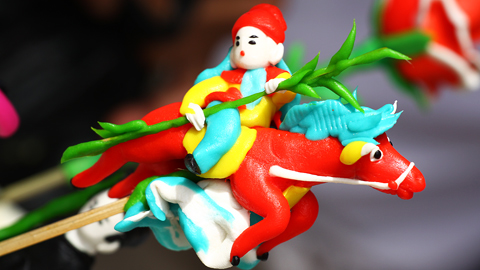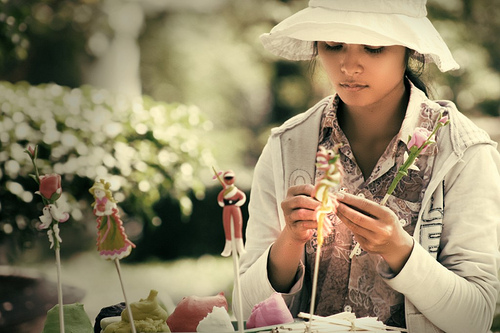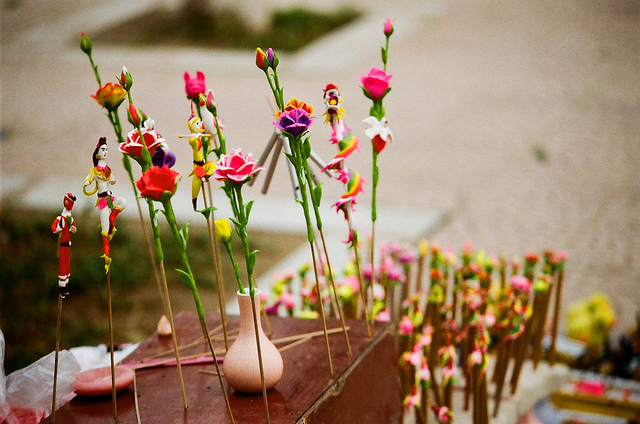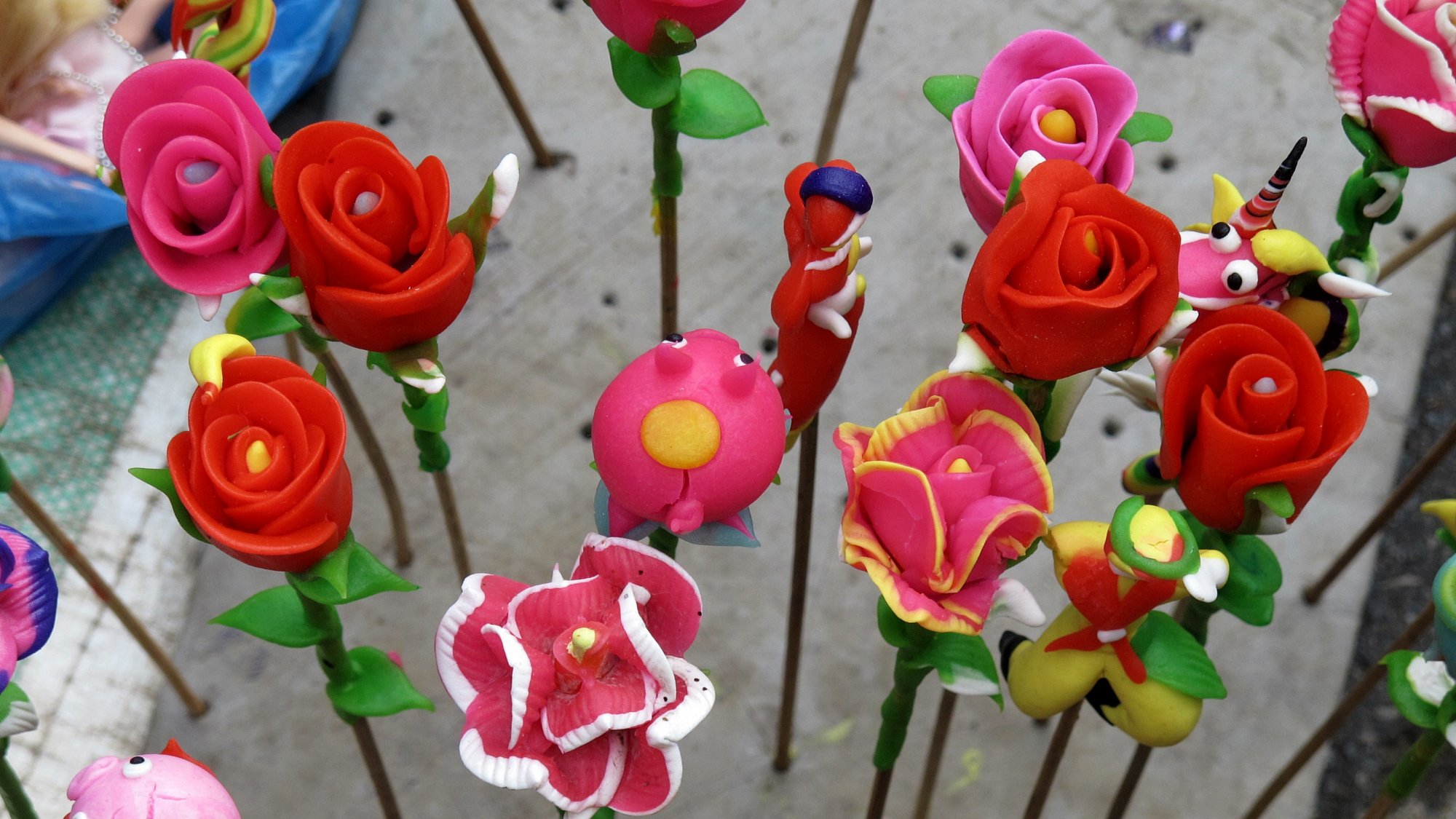In the old days, when comics and illustrated books had yet come into existence in Vietnam, “tò he” was made to depict different heroes and ordinary people of daily life, symbolic animals like dragon or phoenix or daily-viewed water buffalos, flowers and all beautiful things in fairy and history tales. Children gethered at the common place of the village to listen to stories, see the king and mandarins in their elaborate costumes made by skillful craftsmen to imagine the whole vivid world of heroes and fairies.
The village of Xuan La in Phu Xuyen District, Hanoi is well-known for its skill in making delicate “tò he” toys. “Tò he” makers do not teach the craft to women because the fathers fear their daughters will reveal precious trade secrets to their husbands’ families.
Interesting characteristics
According to an old man in Xuan La Village, the recipe for success in making “tò he” lies in the preparation of the dough. The craftsman first grinds rice into fine powder, then pours water into the powder and mixes it until he achieves a sticky lump. He places the lump in a pot of water, brings the water to a boil, and cooks the paste for an hour. When the lump rises to the water’s surface, dips, and rises again, the craftsman removes it from the pot. Then he applies seven colours: white. black, green, yellow, violet, pink, and red. Miraculously, the different colours never stain one another when he assembles the parts of a to lie figurine.

Many generations of Vietnamese children have been overjoyed when their mothers return from market with a “tò he”. Children can even eat “tò he” after playing with them. Each Xuan La craftsman embarking on the “tò he” trade learns to humour customers, especially children. The lesson of humanity is the first one every Xuan La villager bears in mind. “If we love people, they will surely come to us,” “tò he” makers say.
Making “tò he” does not bring much profit. The materials of rice paste, bamboo-stick holders, colourings are inexpensive and locally available. A craftsman only charges customers for his patience and care. Customers can place their orders, watch the craftsman mould the toy, and be pleased with the results in minutes. A “tò he” can depict a person, a famous general, a folk-tale character, an animal, or a flower. The makers remember the characteristics of every subject. They are experts in using exactly the right amount of paste to form each separate part of each kind of toy as if these skills were an inborn talent.

Mr. Dang Van To who is eighty-two, is the oldest “tò he” maker in Xuan La. He talks proudly about his life and career. Mr. To’s family has been making “tò he” for ten generations. He learned the trade when he was six and is nationally known. The Ministry of Culture and Information often asks him to demonstrate “tò he” making at festivals. Mr. To’s passion and skill have not lessened despite his age. He can make every kind of “tò he”, from kings and mandarins with elaborate imperial costumes to complicated dragons. He can finish an image of King Quang Trung – a national hero, in less than ten minutes.
…and the meaningful lessons
It was also the moment when the tradition, lessons of virtues and morals were passed on to the young generation. Xuan La village is the place where passionate craftsmen follow generations of family to carry on with their “tò he” toys and the adventure of imaginative figurines despite the overwheming influx of modern toys and illustrated books.

Mr. To also likes to teach children about the underlying meaning of “tò he”. He explains that the lifeline of the “tò he” trade is people’s joy, not money. For example, as Mr. To creates a “tò he” rat, he explains that rats have pointed noses and long tails, that they destroy farmers’ crops, and that the children should help get rid of rats. The children are fascinated to listen to Mr. To as they watch the “tò he” emerge in his hands.
Today, plastic and electronic toys flood city and countryside markets. Although “tò he” cannot compete, Xuan La villagers still struggle to maintain their traditional trade. At present, about 300 villagers make “tò he”. Chu Van Nghe, a war veteran who is sixty-seven, still pursues the craft. His four-year-old granddaughter has asked him to teach her to make “tò he”. Nowadays, many women assist their husbands and families in preserving the village trade. Everyday, Xuan La villagers travel to different corners of the countryside – from hamlets to markets to parks – selling “tò he” to children and “tò he” lovers.

Xuan La villagers take pride that, nowadays, “tò he” makers can be found nationwide and even abroad in China, Laos, Cambodia and Thailand. This proves that the craft has not entirely disappeared. Although a “tò he” is small, it embodies a lot of the sentiment, honour and industry that began with Xuan La villagers long, long ago.
“Tò he’’ made simple but wonderful gifts of love and tenderness to childern who were longing for mother coming back from market shift. These simple toys still give children immense joy during the Mid-Autumn season.
Danh du” (Swings) have been traditional game at Vietnamese village festivals for centuries. The game is most...
For a long time, together with horizontal lacquered boards engraved with Chinese characters, parallel sentences written...
Longevity wishing ceremony is to wish an elderly person longevity. That is a Vietnamese custom, when their grandparents...
The “khan dong” is a black piece of fabric wrapped around a girl’s long hair so that it forms a tube around...
Though today, people in Vietnam use the western calendar for most practical matters of daily life, the old system still...
Throughout centuries, traditional crafts and craft villages have been existed and developed as an integral part of Thai...
Composing, challenging and displaying parallels represents an elegant cultural activity of the Vietnamese people. On...
“Diều sáo” (kite flying) are Vietnamese kites that make music, so interesting! If you are in Vietnam, you will...